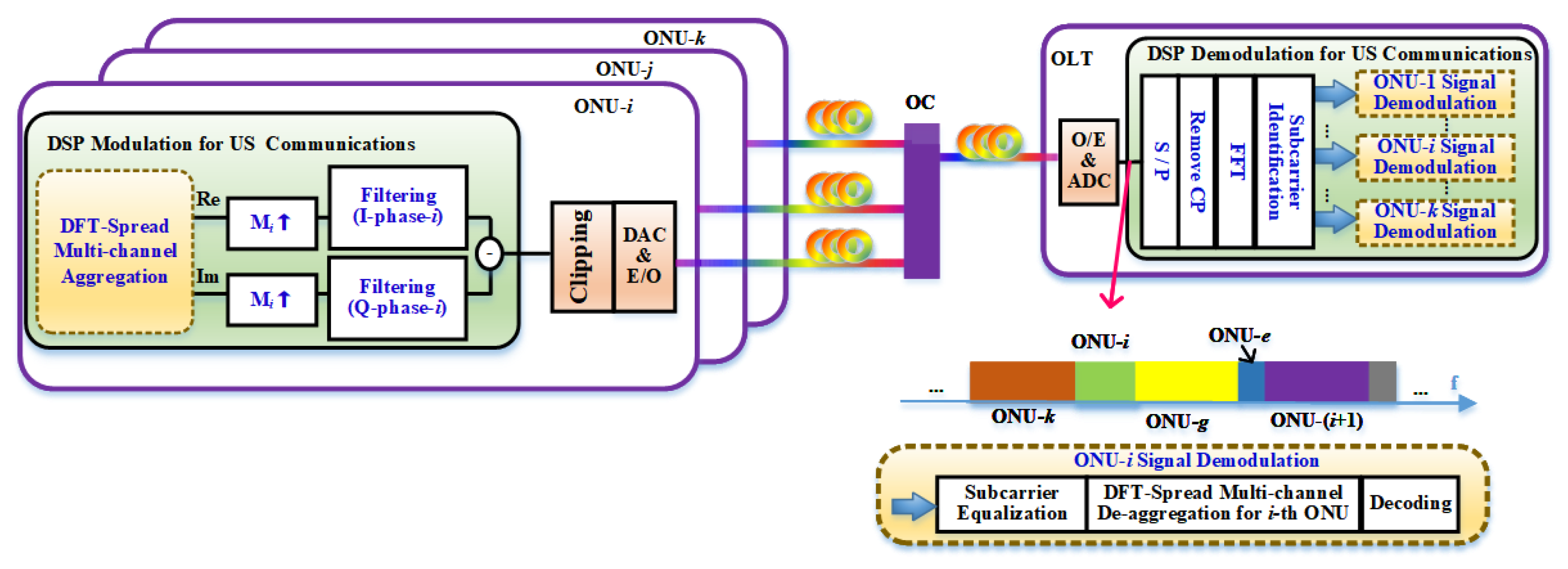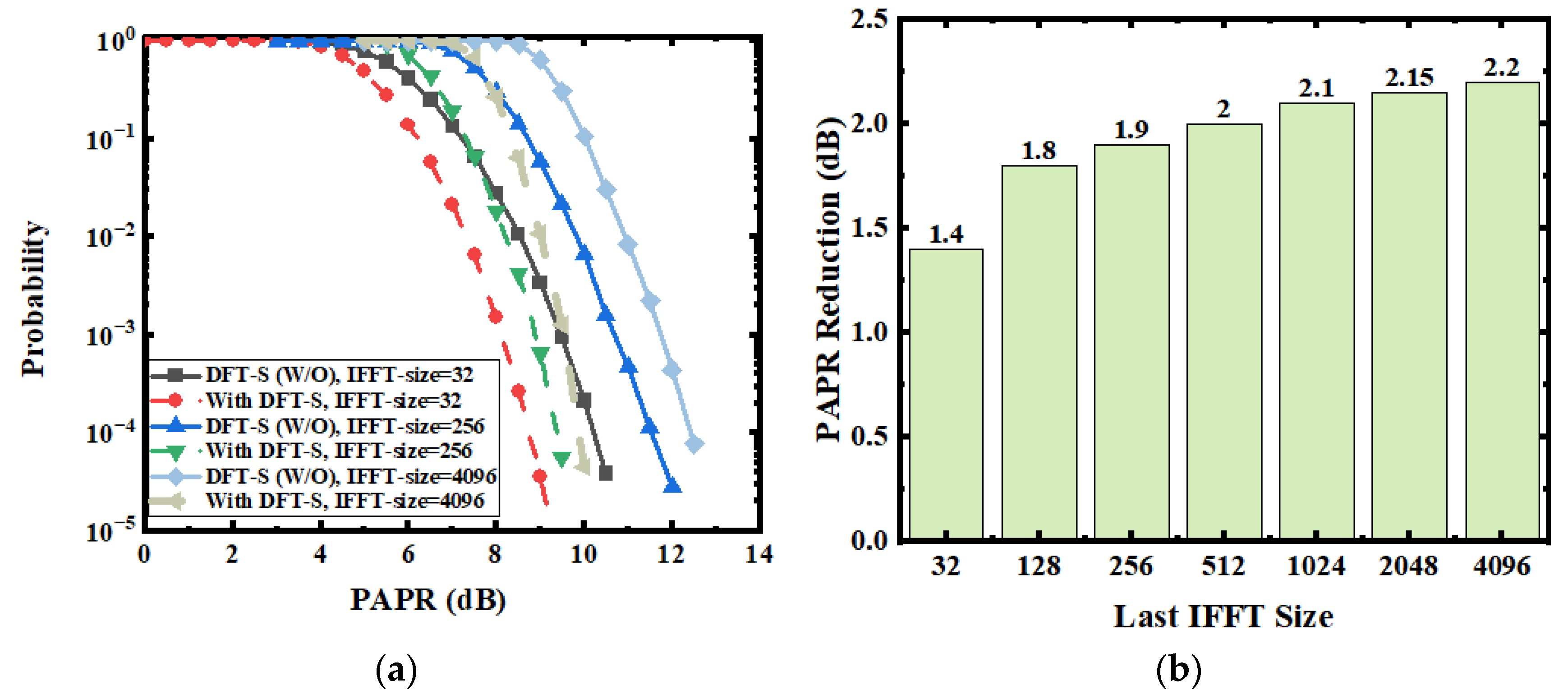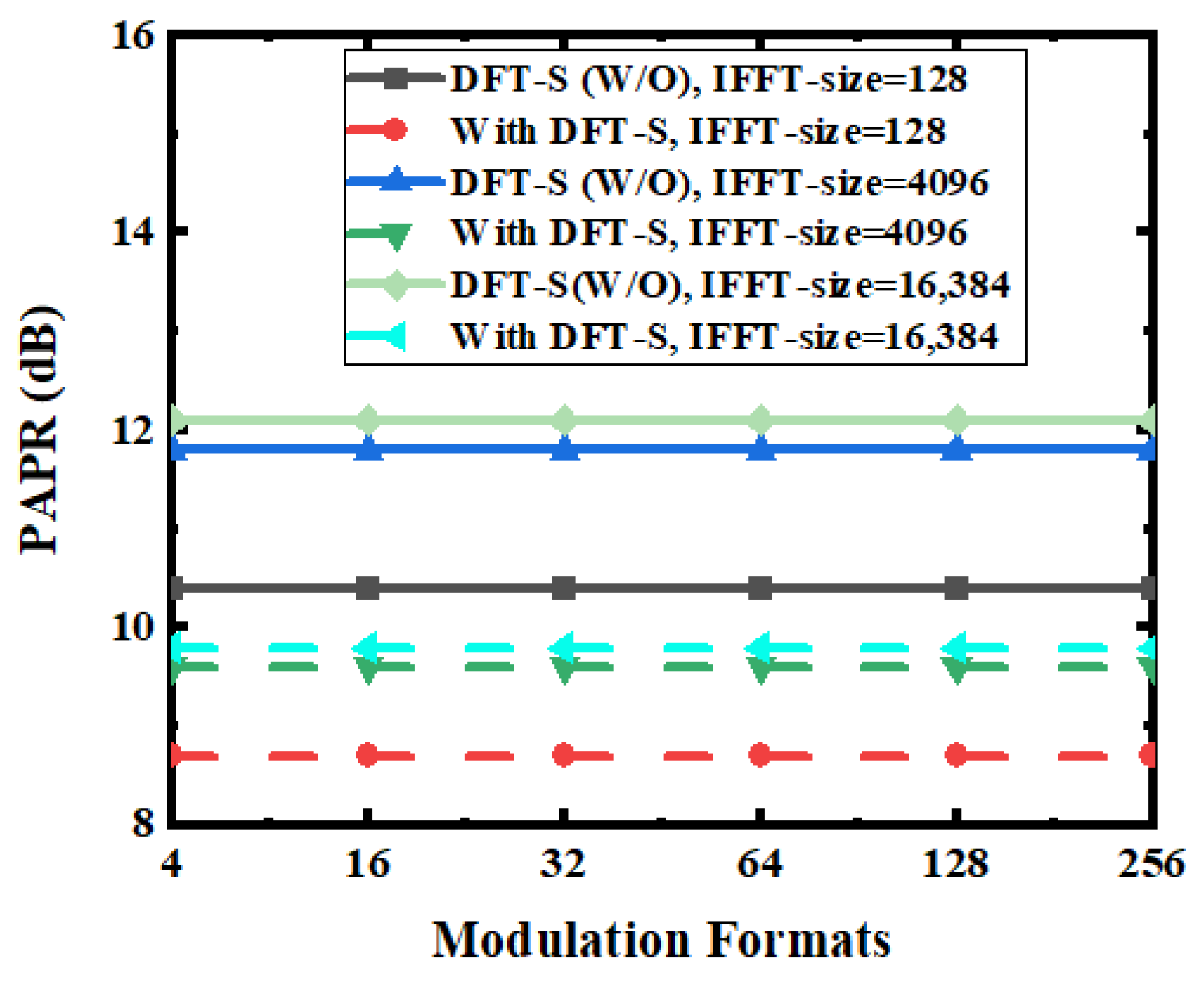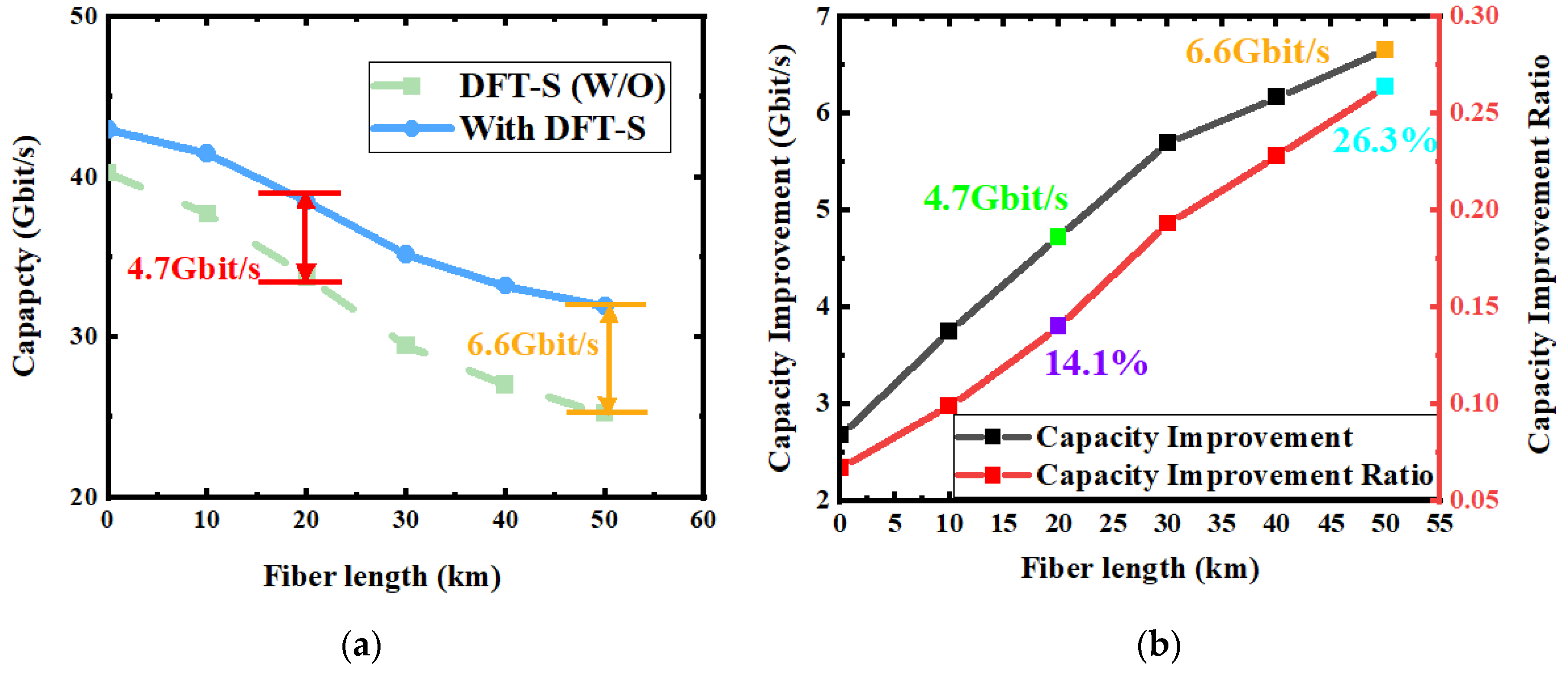Improved Performances in Point-to-Multipoint Flexible Optical Transceivers Utilizing Cascaded Discrete Fourier Transform-Spread Inverse Fast Fourier Transform/Fast Fourier Transform-Based Multi-Channel Aggregation/De-Aggregation
Abstract
1. Introduction
2. Operating Principle of Cascaded DFT-Spread IFFT/FFT-Based P2MP Flexible Transceivers
2.1. Cascaded DFT-Spread IFFT for Multi-Channel Aggregation in Transmitter DSPs
2.2. Cascaded DFT-Spread FFT for Multi-Channel De-Aggregation in Receiver DSPs
3. PAPR of Cascaded DFT-Spread IFFT-Based Multi-Channel Aggregation
3.1. The Impact of the Last IFFT Size
3.2. The Impact of Modulation Formats
3.3. The Impact of the Channel Count
4. Performances of IMDD Upstream PONs Incorporating DFT-Spread P2MP Flexible Transceivers
4.1. Optimal Clipping Ratio and Quantization Bit
4.2. 20 km Upstream Transmission Performances
4.3. Maximum Achievable Aggregated Upstream Signal Transmission Capacity
5. Conclusions
Author Contributions
Funding
Institutional Review Board Statement
Informed Consent Statement
Data Availability Statement
Conflicts of Interest
References
- Lian, K.; Xu, Z.; Qiao, M.; Li, Z.; Wang, J.; Liu, J.; Wang, D. Optical Multi-Path Interference Mitigation for PAM4-IMDD Systems Using Balanced Coding. J. Light. Technol. 2024, 42, 5918–5927. [Google Scholar] [CrossRef]
- Welch, D.; Napoli, A.; Back, J.; Buggaveeti, S.; Castro, C.; Chase, A. Digital Subcarrier Multiplexing: Enabling Software-Configurable Optical Networks. J. Light. Technol. 2023, 41, 1175–1191. [Google Scholar] [CrossRef]
- González, C.C.; Pupo, E.F.; Iradier, E.; Angueira, P.; Murroni, M.; Montalban, J. Network Selection Over 5G-Advanced Heterogeneous Networks Based on Federated Learning and Cooperative Game Theory. IEEE Trans. Veh. Technol. 2024, 73, 11862–11877. [Google Scholar] [CrossRef]
- Gonem, O.F.A.; Giddings, R.P.; Tang, J. Experimental Demonstration of Soft-ROADMs With Dual-Arm Drop Elements for Future Optical-Wireless Converged Access Networks. J. Light. Technol. 2024, 42, 1773–1785. [Google Scholar] [CrossRef]
- Chen, L.; Jin, W.; He, J.; Giddings, R.P.; Huang, Y.; Tang, J. A Point-to-Multipoint Flexible Transceiver for Inherently Hub-and-Spoke IMDD Optical Access Networks. J. Light. Technol. 2023, 41, 4743–4754. [Google Scholar] [CrossRef]
- Jin, W.; Sankoh, A.; Dong, Y.; Zhong, Z.-Q.; Giddings, R.P.; O’Sullivan, M.; Lee, J.; Durrant, T.; Tang, J. Hybrid SSB OFDM-digital filter multiple access PONs. J. Light. Technol. 2020, 38, 2095–2105. [Google Scholar] [CrossRef]
- Jin, W.; Chen, L.; He, J.; Giddings, R.P.; Huang, Y.; Hao, M.; Faruk, S.; Yi, X.; Wang, T.; Tang, J. Concurrent Direct Inter-ONU and Upstream Communications in IMDD PONs Incorporating P2MP Flexible Optical Transceivers and Advanced Passive Remote Nodes. Photonics 2024, 11, 1021. [Google Scholar] [CrossRef]
- Hu, J.; Wang, Y.; Lian, Z.; Su, Y.; Xie, Z. Low-Complexity PAPR Reduction of OFDM-IM Signals via ADMM Approaches. IEEE Commun. Lett. 2024, 28, 1161–1165. [Google Scholar] [CrossRef]
- Kumar, A.; Sharma, H.; Gaur, N.; Gour, N. PAPR Analysis of 5G and B5G Waveforms Using Advanced PAPR Algorithms. IT Prof. 2024, 26, 17–21. [Google Scholar] [CrossRef]
- Vinayakamoorthi, N.; Vaiyamalai, S. Modified μ-law root Companding for PAPR reduction in GFDM signals. Phys. Commun. 2023, 57, 101974. [Google Scholar] [CrossRef]
- Chen, L.; Huang, X.; Jin, W.; Wang, X.; Yang, G.; Jiang, M.; Huang, Y.; Tang, J. Analyzing Peak-to-Average Power Ratio Characteristics in Multi-Channel Intensity Modulation and Direct Detection Flexible Transceivers Deploying Inverse Fast Fourier Transform/Fast Fourier Transform-Based Processing. Sensors 2023, 23, 9804. [Google Scholar] [CrossRef]
- Huang, Y.; Yang, P.; Zammit, S.; Yang, N.; Wu, G.; Mordachev, V. A Dual-Function OFDM Waveform Design for Future Multicarrier Communication. IEEE Commun. Lett. 2024, 28, 1624–1628. [Google Scholar] [CrossRef]
- Nguyen, T.K.; Nguyen, H.H.; Salt, J.E.; Howlett, C. Optimization of Partial Transmit Sequences for PAPR Reduction of OFDM Signals Without Side Information. IEEE Trans. Broadcast. 2023, 69, 313–321. [Google Scholar] [CrossRef]
- Dong, Y.X.; Jin, W.; Giddings, R.P.; O’sullivan, M.; Tipper, A.; Durrant, T.; Tang, J.M. Hybrid DFT-Spread OFDM-Digital Filter Multiple Access PONs for Converged 5G Networks. J. Opt. Commun. Netw. 2019, 11, 347–353. [Google Scholar] [CrossRef]
- Chae, J.; Choi, J.; Kim, J.; Cho, J.H. A Low-Complexity Widely-Linear MMSE Equalizer for DFT-Spread OFDM With Frequency-Domain Spectrum Shaping. IEEE Trans. Wirel. Commun. 2024, 23, 3465–3479. [Google Scholar] [CrossRef]
- Zhong, Z.; Jin, W.; Dong, Y.; Sankoh, A.; He, J.; Hong, Y.; Giddings, R.P.; Pierce, I.; Oasullivan, M.; Lee, J.; et al. Experimental demonstrations of matching filter-free digital filter multiplexed SSB OFDM IMDD transmission systems. IEEE Photonics J. 2021, 13, 7900512. [Google Scholar] [CrossRef]
- Rahmatallah, Y.; Mohan, S. Peak-To-Average Power Ratio Reduction in OFDM Systems: A Survey And Taxonomy. IEEE Commun. Surv. Tutor. 2013, 15, 1567–1592. [Google Scholar] [CrossRef]
- Zhong, X.; Qi, J.; Bao, J. Using clipping and filtering algorithm to reduce PAPR of OFDM system. In Proceedings of the 2011 International Conference on Electronics, Communications and Control (ICECC), Ningbo, China, 9–11 September 2011; pp. 1763–1766. [Google Scholar]
- Bertran, E.; Porta, O.; Montoro, G.; Delgado-Penín, J.A. On PAPR for combined modulation and access techniques in Configurable Radio. In Proceedings of the 2010 IEEE International Microwave Workshop Series on RF Front-Ends for Software Defined and Cognitive Radio Solutions (IMWS), Aveiro, Portugal, 22–23 February 2010; pp. 1–4. [Google Scholar]
- Iraqi, Y.; Al-Dweik, A. Adaptive Bit Loading with Reduced Computational Time and Complexity for Multicarrier Wireless Communications. IEEE Trans. Aerosp. Electron. Syst. 2020, 56, 2497–2506. [Google Scholar] [CrossRef]
- Souza, R.H.; Kiohara, P.; Ghisa, L.; Guegan, M.; Quintard, V.; Coutinho, O.L.; Pérennou, A.; Almeida, V.R. Analog Response in Optically Powered Radio-Over-Fiber Links With Distributed Amplification in Single-Mode Fibers. J. Light. Technol. 2023, 41, 7083–7091. [Google Scholar] [CrossRef]









| Parameter | Value |
|---|---|
| ONU count | 4 |
| Channel count for each ONU | 4 |
| IFFT/FFT sizes for multi-channel aggregation | 256/512/1024 |
| Data-bearing subcarriers in each channel | 128/128/256/512 |
| Modulation formats | 16 QAM |
| Cyclic prefix | 12.5% |
| DAC and ADC sampling rate | 12.5 GS/s |
| ONU optical launch power | 8 dBm |
| PIN detector sensitivity | −19 dBm |
| PIN responsivity | 0.8 A/W |
| ONU wavelength frequency | 193.1 THz |
| Fiber attenuation | 0.2 dB/km |
| SSMF dispersion parameter at 1550 nm | 16 ps/nm/km |
| Orthogonal digital filter length | 32 |
| DAC/ADC resolution | 8 bits |
| Digital up-sampling factor (M) | M = 8 |
| Clipping ratio (With DFT-S/Without DFT-S) | 10 dB/11 dB |
| Kerr coefficient | 2.35 × 10−20 m2/W |
| ONU1 | ONU2 | ONU3 | ONU4 | Total |
|---|---|---|---|---|
| 5.55 | 5.55 | 5.55 | 5.55 | 22.2 |
Disclaimer/Publisher’s Note: The statements, opinions and data contained in all publications are solely those of the individual author(s) and contributor(s) and not of MDPI and/or the editor(s). MDPI and/or the editor(s) disclaim responsibility for any injury to people or property resulting from any ideas, methods, instructions or products referred to in the content. |
© 2025 by the authors. Licensee MDPI, Basel, Switzerland. This article is an open access article distributed under the terms and conditions of the Creative Commons Attribution (CC BY) license (https://creativecommons.org/licenses/by/4.0/).
Share and Cite
Chen, L.; Gao, Y.; Jin, W.; Yang, H.; Jiang, S.; Liu, S.; Huang, Y.; Tang, J. Improved Performances in Point-to-Multipoint Flexible Optical Transceivers Utilizing Cascaded Discrete Fourier Transform-Spread Inverse Fast Fourier Transform/Fast Fourier Transform-Based Multi-Channel Aggregation/De-Aggregation. Photonics 2025, 12, 106. https://doi.org/10.3390/photonics12020106
Chen L, Gao Y, Jin W, Yang H, Jiang S, Liu S, Huang Y, Tang J. Improved Performances in Point-to-Multipoint Flexible Optical Transceivers Utilizing Cascaded Discrete Fourier Transform-Spread Inverse Fast Fourier Transform/Fast Fourier Transform-Based Multi-Channel Aggregation/De-Aggregation. Photonics. 2025; 12(2):106. https://doi.org/10.3390/photonics12020106
Chicago/Turabian StyleChen, Lin, Yingxue Gao, Wei Jin, Han Yang, Shenming Jiang, Shu Liu, Yi Huang, and Jianming Tang. 2025. "Improved Performances in Point-to-Multipoint Flexible Optical Transceivers Utilizing Cascaded Discrete Fourier Transform-Spread Inverse Fast Fourier Transform/Fast Fourier Transform-Based Multi-Channel Aggregation/De-Aggregation" Photonics 12, no. 2: 106. https://doi.org/10.3390/photonics12020106
APA StyleChen, L., Gao, Y., Jin, W., Yang, H., Jiang, S., Liu, S., Huang, Y., & Tang, J. (2025). Improved Performances in Point-to-Multipoint Flexible Optical Transceivers Utilizing Cascaded Discrete Fourier Transform-Spread Inverse Fast Fourier Transform/Fast Fourier Transform-Based Multi-Channel Aggregation/De-Aggregation. Photonics, 12(2), 106. https://doi.org/10.3390/photonics12020106






